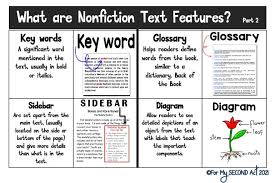Introduction
Definition of Text Features
Text features are additional elements added to written content to help guide readers and enhance their comprehension of the material. These features provide a way to visually organize information and offer context that makes it easier to understand and retain essential details. Some standard text features include headings, subheadings, images, captions, charts, bullet points, and glossaries. These elements break up dense paragraphs and draw attention to key points in the content, providing a more organized, efficient reading experience.
Why Are Text Features Important for Reading and Comprehension?
Text features play a crucial role in reading comprehension. They allow readers to navigate the material quickly, identify the most critical sections, and locate specific information without reading through every word. They are handy for academic and professional reading, where efficiency and clarity are essential. By learning to recognize and use text features effectively, readers can enhance their understanding, speed, and overall experience with written materials.
Types of Text Features and Their Functions

Headings and Subheadings
Headings and subheadings are some of the most common text features in books, articles, and reports. They organize the content and break it into manageable sections. A heading typically introduces a new section or topic, while subheadings further break down the content into smaller, more specific points. These features allow readers to skim through the material quickly and get an overview of what is discussed in each section.
Headings and subheadings serve as a roadmap for readers, guiding them to the most interesting information. They provide a structured layout, especially for non-fiction books and articles, where the main goal is to present factual, organized information. By scanning headings and subheadings, readers can quickly identify which section contains the information they seek and whether it aligns with their needs or interests.
Captions and Images
Captions and images enhance the written content by offering visual representation and context. Images help break up the text and provide a visual context that makes the content more engaging and easier to understand. A well-placed image can clarify complex ideas or provide examples reinforcing the message.
Captions are typically brief descriptions placed under or beside an image to explain or expand on what the image represents. They are essential in providing context to images, allowing readers to connect the visuals with the content. For instance, an image of a cell structure in a science textbook will have a caption explaining its different parts. Captions summarize key points, making them vital for comprehension and information retention.
Graphs, Charts, and Tables
Graphs, charts, and tables are essential text features, mainly when dealing with data-heavy content such as scientific reports, business documents, and educational materials. These features present numerical or statistical information in a visual format, making it easier for readers to grasp the key points without wading through lengthy paragraphs of text.
Graphs, charts, and tables simplify the presentation of complex information, allowing readers to interpret and compare data quickly. For example, a line graph can show trends over time, while a pie chart can break down percentages within a whole. These features help readers make sense of numbers by visually representing the data, which enhances comprehension and retention.
Bold, Italic, and Underlined Text
Bold, italic, and underlined text are formatting styles that draw attention to important words or phrases within a body of text. These text features often highlight key terms, concepts, or ideas central to the reader’s understanding of the content. Bold text is typically used for headings or to emphasize a word or phrase, while italics are often used for book titles, foreign words, or to convey emphasis more subtly.
Underlined text is less commonly used in printed materials but may appear in digital content, especially hyperlinks. These formatting styles help readers quickly identify critical information, guiding them to the most relevant parts of the content. Proper use of bold, italic, and underlined text ensures that key ideas are noticed, facilitating a deeper understanding of the material.
Sidebars and Text Boxes
Sidebars and text boxes are features commonly found in textbooks, magazines, and online articles. A sidebar is a vertical column or box alongside the main content that provides additional information, examples, or related topics. Sidebars are often used to elaborate on specific ideas mentioned in the primary text without disrupting the flow of the main discussion.
On the other hand, text boxes are smaller sections of text placed in the margins or within the body of the article. These are used to highlight definitions, essential facts, or key insights. Both sidebars and text boxes are valuable supplementary tools for providing more depth to the content. They help readers gain a more comprehensive understanding of the topic by offering additional context or expanding on essential concepts.
Glossary and Index
The glossary and index are essential text features in textbooks, technical manuals, and reference materials. A glossary is a list of key terms and their definitions, usually at the end of a book or chapter. It helps readers quickly find the meaning of unfamiliar words or concepts. The glossary is an essential tool for students and researchers, as it allows them to comprehend specialized vocabulary without needing to search outside the text.
An index, typically located at the back of a book, is an alphabetical list of topics, terms, and names discussed in the text, along with the page numbers where they can be found. The index is a reference guide, allowing readers to locate specific information quickly. Both the glossary and index improve the usability of the text, making it more accessible and reader-friendly.
How to Effectively Use Text Features
Improving Comprehension
Text features are designed to aid comprehension by organizing information to make it easier for readers to understand. By learning to use these features, readers can navigate through content more effectively and focus on the most critical sections. Headings and subheadings, for example, provide a clear structure, allowing readers to understand the flow of the material and identify key concepts. Images, captions, and graphs further support understanding by presenting visual cues reinforcing the written content.
When using text features to improve comprehension, paying attention to how they are used is essential. For instance, if a heading indicates a new section, the reader should prepare to dive into a new topic or concept. Understanding the purpose of text features helps readers extract information more efficiently and retain it longer.
Enhancing Speed and Efficiency
Text features improve comprehension and help readers increase their reading speed. Headings and subheadings allow for quick skimming of the material, enabling readers to locate key sections without reading everything in detail. Similarly, bullet points and numbered lists provide a concise overview of the main points, making it easier to digest the material quickly.
Visual elements such as charts and graphs also speed up the reading process by presenting complex data in an easy-to-understand format. By leveraging text features to their advantage, readers can enhance their ability to retrieve information quickly, whether studying for an exam or reviewing a report for work.
Applying Text Features in Academic and Professional Writing
In academic and professional writing, text features are essential for creating clear, accessible documents. Research papers, essays, and reports often rely on headings, subheadings, and lists to organize the content and highlight the most critical points. By using these text features, writers can ensure that their ideas are presented in a way that is easy for readers to follow.
Text features like charts, tables, and sidebars are crucial for conveying data and providing additional context in business and professional settings. Effectively using these features can help writers present complex information in a more digestible format, ensuring that their audience grasps the key points without feeling overwhelmed.
Common Challenges with Text Features and How to Overcome Them
Overwhelming or Distracting Features
While text features can significantly enhance the reading experience, it’s possible to overuse them, leading to a cluttered and overwhelming page. Too many images, graphs, or sidebars can distract from the main content and make it difficult for readers to focus on the primary message. To avoid this, it’s essential to use text features sparingly and purposefully, ensuring each feature serves a specific function in aiding comprehension.
Not Understanding the Purpose of Certain Features
One of the challenges readers face is misinterpreting or underestimating the value of certain text features. For example, readers may overlook captions or glossaries, thinking they aren’t necessary to understand the material. However, these features provide critical context and clarification. To overcome this, readers should understand the purpose of each feature and how it contributes to the overall comprehension of the content.
Inconsistency in Formatting
Inconsistent use of text features can also create confusion. For instance, if headings are not formatted consistently throughout a document, it may become difficult for readers to follow the structure. To avoid this, writers should ensure that formatting is uniform across the text. Style guides and templates can help maintain consistency, ensuring that text features are straightforward and easy to understand.
Conclusion
Text features are an indispensable part of modern reading and writing, improving comprehension, speed, and overall engagement with the material. From headings and subheadings to images, charts, and glossaries, these elements are vital in organizing content and guiding readers to the most relevant information. By learning to use text features effectively, readers and writers can enhance their ability to communicate and comprehend complex ideas.




